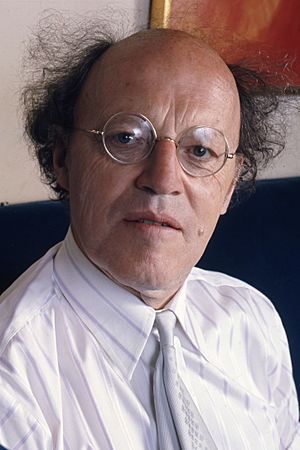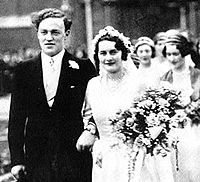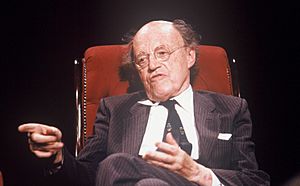Frank Pakenham, 7th Earl of Longford facts for kids
Quick facts for kids
The Earl of Longford
|
|
|---|---|

Longford in 1974
|
|
| Leader of the House of Lords | |
| In office 18 October 1964 – 16 January 1968 |
|
| Monarch | Elizabeth II |
| Prime Minister | Harold Wilson |
| Preceded by | The Lord Carrington |
| Succeeded by | The Lord Shackleton |
| Lord Keeper of the Privy Seal | |
| In office 6 April 1966 – 16 January 1968 |
|
| Monarch | Elizabeth II |
| Prime Minister | Harold Wilson |
| Preceded by | Sir Frank Soskice |
| Succeeded by | The Lord Shackleton |
| In office 18 October 1964 – 23 December 1965 |
|
| Monarch | Elizabeth II |
| Prime Minister | Harold Wilson |
| Preceded by | Selwyn Lloyd |
| Succeeded by | Sir Frank Soskice |
| Secretary of State for the Colonies | |
| In office 23 December 1965 – 6 April 1966 |
|
| Monarch | Elizabeth II |
| Prime Minister | Harold Wilson |
| Preceded by | Anthony Greenwood |
| Succeeded by | Frederick Lee |
| First Lord of the Admiralty | |
| In office 24 May 1951 – 13 October 1951 |
|
| Monarch | George VI |
| Prime Minister | Clement Attlee |
| Preceded by | The Viscount Hall |
| Succeeded by | James Thomas |
| Minister of Civil Aviation | |
| In office 31 May 1948 – 1 June 1951 |
|
| Monarch | George VI |
| Prime Minister | Clement Attlee |
| Preceded by | The Lord Nathan |
| Succeeded by | The Lord Ogmore |
| Chancellor of the Duchy of Lancaster (Deputy Secretary of State for Foreign Affairs) |
|
| In office 17 April 1947 – 31 May 1948 |
|
| Monarch | George VI |
| Prime Minister | Clement Attlee |
| Preceded by | John Hynd |
| Succeeded by | Hugh Dalton |
| Parliamentary Under-Secretary of State for War | |
| In office 4 October 1946 – 17 April 1947 |
|
| Monarch | George VI |
| Prime Minister | Clement Attlee |
| Preceded by | The Lord Nathan |
| Succeeded by | John Freeman |
| Lord-in-waiting Government Whip |
|
| In office 14 October 1945 – 4 October 1946 |
|
| Monarch | George VI |
| Prime Minister | Clement Attlee |
| Preceded by | The Lord Alness |
| Succeeded by | The Lord Chorley |
| Member of the House of Lords | |
| as a hereditary peer 16 October 1945 – 11 November 1999 |
|
| Preceded by | Peerage created |
| Succeeded by | Seat abolished |
| as a life peer 17 November 1999 – 3 August 2001 |
|
| Personal details | |
| Born |
Francis Aungier Pakenham
5 December 1905 |
| Died | 3 August 2001 (aged 95) |
| Nationality | British |
| Political party | Labour |
| Spouse |
Elizabeth Harman
(m. 1931) |
| Children | 8, including Antonia, Thomas, Judith, Rachel, and Michael |
| Parents | Thomas Pakenham, 5th Earl of Longford Lady Mary Child-Villiers |
| Alma mater | New College, Oxford |
Francis Aungier Pakenham, 7th Earl of Longford, 1st Baron Pakenham, Baron Pakenham of Cowley, KG, PC (5 December 1905 – 3 August 2001), known to his family as Frank Longford and styled Lord Pakenham from 1945 to 1961, was a British politician and social reformer. A member of the Labour Party, he was one of its longest-serving politicians. He held cabinet positions on several occasions between 1947 and 1968. Longford was politically active until his death in 2001. A member of an old, landed Anglo-Irish family, the Pakenhams (who became Earls of Longford), he was one of the few aristocratic hereditary peers ever to serve in a senior capacity within a Labour government.
Longford was famed for championing social outcasts and unpopular causes. He is especially notable for his lifelong advocacy of penal reform. Longford visited prisons on a regular basis for nearly 70 years until his death. He advocated for rehabilitation programmes and helped create the modern British parole system in the 1960s following the abolition of the death penalty. The Longford Prize is named after him. It is awarded annually during the Longford Lecture and recognises achievement in the field of penal reform.
Contents
Background and education
Born into an Anglo-Irish aristocratic family, he was the second son of Thomas Pakenham, 5th Earl of Longford in the Peerage of Ireland. He was educated at Eton College and New College, Oxford, where as an undergraduate he was a member of the Bullingdon Club. Despite having failed to be awarded a scholarship, he graduated with a first-class honours degree in Philosophy, Politics, and Economics and became a don at Christ Church.
Political career
After a disastrous spell in stockbroking with Buckmaster & Moore, in 1931 the 25-year-old Pakenham joined the Conservative Research Department where he developed education policy for the Conservative Party. His wife Elizabeth persuaded him to become a socialist. They were married on 3 November 1931 and had eight children. In 1940, only a few months after the onset of the Second World War, he suffered a nervous breakdown and was invalided out of the armed forces. The same year, he became a Roman Catholic. His wife was initially dismayed by this, for she had been brought up a Unitarian and associated the Church of Rome with reactionary politics, but in 1946 she joined the same church.
Pakenham embarked on a political career. In July 1945 he contested Oxford against the sitting Conservative member, Quintin Hogg, but was defeated by nearly 3,000 votes. In October of that year he was created Baron Pakenham, of Cowley in the City of Oxford, in the Peerage of the United Kingdom, by the Labour government of Clement Attlee, and took his seat in the House of Lords as one of the few Labour peers. He was immediately appointed a Lord-in-waiting by Attlee. In 1947, he was appointed deputy Foreign Secretary, outside the cabinet, with special responsibility for the British zone in occupied Germany. He made headlines by telling German audiences that the British people forgave them for what had happened in the war; at his death, the Lord Bishop of Birmingham remarked that West German Chancellor Konrad Adenauer was supposed to have "counted him as one of the founders of the Federal Republic". In May 1948, he was moved to the lower-profile role of Minister of Civil Aviation and was sworn of the Privy Council in June of that year. He continued in this post until May 1951. From May until the fall of the administration in October 1951, he was First Lord of the Admiralty.
In 1961, Pakenham inherited from his brother the earldom of Longford in the Peerage of Ireland and from then onward was generally known to the public as Lord Longford. When Labour returned to power in October 1964 under Harold Wilson, Longford was appointed Lord Privy Seal and Leader of the House of Lords, despite the fact that Wilson had little respect for him. In December 1965 he became Secretary of State for the Colonies, continuing as Leader of the House of Lords. After only four months at the Colonial Office, he was removed from the post for failing to master his brief, and again became Lord Privy Seal in April 1966. Wilson often talked about sacking Longford from his government, which is believed by some to have led to Longford's resignation as Lord Privy Seal and Leader of the House of Lords in January 1968 – though the actual occasion of his resignation was the failure of Education Secretary Patrick Gordon Walker to agree to the raising of the school-leaving age. In 1972 he was created a Knight of the Garter.
Penal reform
Longford began visiting prisoners in the 1930s when he was a city councillor in Oxford, and continued to do so every week, all around the country, until shortly before his death in 2001.
In 1956, he set up New Bridge Foundation, an organisation that aimed to help prisoners stay in touch with society and integrate them back into it.
New Bridge set up Inside Time in 1990, the only national newspaper for the UK's prison population. Longford organised many debates on prison reform in the House of Lords from the 1950s onward, and in 1963 chaired the commission whose report recommended reform in sentencing policy and the establishment of a parole system.
House of Lords reforms (1999)
Under the House of Lords Act 1999, the majority of hereditary peers lost the privilege of a seat and right to vote in the House of Lords. However, Longford was one of four individuals who were hereditary peers of the first creation (in his case 1st Baron Pakenham). As such, he was created a life peer, and remained in the Lords as Baron Pakenham of Cowley, of Cowley in the County of Oxfordshire. At the age of 93, he became the second-oldest person to be granted a peerage (after Lord Maenan).
Writings
Known for his interest in Irish history, he wrote a number of books on the topic. Peace By Ordeal: An Account from First-Hand Sources of the Negotiation and Signature of the Anglo-Irish Treaty of 1921, published in 1935, is arguably his best-known work. It documents the negotiations of the Anglo-Irish Treaty of 1921 between Irish and British representatives. His account uses primary sources from the time, many however anonymous. Commentators differ widely on its merits and reliability.
Longford came greatly to admire Éamon de Valera and was chosen as the co-author of his official biography Éamon de Valera, which was published in 1970, co-written with Thomas P. O'Neill. He campaigned for decades to have the Hugh Lane bequest pictures restored to Dublin, and with Lord Moyne and Sir Denis Mahon, brokered a compromise-sharing agreement in 1959.
Personal life
At Oxford, Longford met his wife, Elizabeth Harman, an undergraduate at Lady Margaret Hall. Their marriage produced four sons and four daughters, followed by 26 grandchildren and 18 great-grandchildren.
- Lady Antonia Margaret Caroline Pakenham (b. 27 August 1932), writer; previously married to Hugh Fraser and had six children, was married to Harold Pinter until his death
- Thomas Frank Dermot Pakenham, 8th Earl of Longford (b. 14 August 1933), historian; married with issue (four children)
- Hon. Patrick Maurice Pakenham (17 April 1937 – 8 June 2005), barrister; married Mary Plummer, three children
- Judith Elizabeth Pakenham (14 August 1940 – 18 September 2018), writer; previously married to Alexander John Kazantzis, two children
- Lady Rachel Mary Pakenham (b. 11 April 1942), writer; married to director Kevin Billington, four children
- Hon. Sir Michael Aidan Pakenham (b. 3 November 1943), diplomat; married to Meta Landreth Doak, two children
- Lady Catherine Rose Pakenham (28 February 1946 – 11 August 1969), journalist; died in a car accident, unmarried.
- Hon. Kevin John Toussaint Pakenham (1 November 1947 – 19 July 2020), banker; married to Ruth Jackson, then Claire Hoare, then Ronke Phillips; six children.
Longford died in August 2001 at the age of 95, and was cremated at Mortlake Crematorium.
His wife, Elizabeth Pakenham, Countess of Longford, died in October 2002 at the age of 96. She was the author of Victoria R.I. (1964), a biography of Queen Victoria, published in the US as Born to Succeed. She also wrote a two-volume biography of the Duke of Wellington, and a volume of memoirs, The Pebbled Shore. She stood for Parliament as Labour candidate for Cheltenham in the 1935 general election and for Oxford in 1950.
The then Prime Minister, Tony Blair, said of Longford after his death: "He was a great man of passionate integrity and humanity, and a great reformer committed to modernising the law, while also caring deeply for individuals".
See also
- The Longford Lectures
- The Longford Prize



